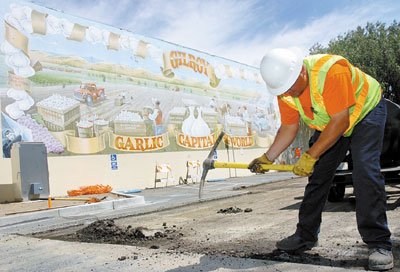Be patient: Downtown is evolving, and the next step is to fill
apartments and condos with shopping tenants.
Be patient: Downtown is evolving, and the next step is to fill apartments and condos with shopping tenants.
Downtown Gilroy looks as though it’s on the upswing to some, yet stagnant to others. There are 30 so-called “unreinforced masonry buildings” prone to crumbling or worse during an earthquake, and many property owners say the repair and rebuilding process is too expensive. More and more residents are also pinching pennies now, and downtown merchants – most of whom don’t stay open past 7 or 8 p.m. – say the retail mecca east of Gilroy lures a good chunk of their remaining customers away, and when they do come, they complain about parking.
But the economy ebbs and flows, and business and property owners and city officials all agree that downtown has come a long way from its dilapidated state a few years ago. Plus, when the hundreds of condos and apartments fill with tenants throughout the next few years, and the new arts center materializes, more feet will wander those new sidewalks. Until then, Mayor Al Pinheiro said it’s up to the city’s current residents to propel downtown development.
“It’s not just what the mayor and the council can do, but what residents can do,” he said. Still, Pinheiro and Councilmembers Dion Bracco and Cat Tucker will compose a task force and meet with the Economic Development Corporation, the Chamber of Commerce and the Downtown Association to discuss downtown fee waivers and businesses they’d like to see in the area, such as restaurants, wine bars, bakeries and ice cream parlors, Pinheiro said.
“That’s what I call the next evolution, plus the residential units coming online in the next year or two. I hope that’ll be the next shot in the arm,” Pinheiro said. “But unless people start participating and be a part of the solution, it’s never going to happen. They have to come down and patronize the businesses. If they’re successful, then the next guy is going to want to set up shop next to them.”
The city council made it easier for residents to visit downtown last month by adding a 600 square-foot sliver of pavement to the city’s spacious, 100-plus spot parking lot between Eigleberry Street and Gourmet Alley. EDC President Larry Cope and Pinheiro also envision a vine-laden paseo leading from the lot to Monterey Street to mitigate an otherwise drab walk.
“Downtown is an evolution. It will take time to evolve out of its current state right now,” Cope said. “Once the URMs and residential building process have gone through, you get the shoppers, and that’s when you’ll start seeing more mom and pops and then more regional businesses, and once the market is warmed up, that’s when the nationals come in.”
There are 267 residential units under construction downtown, and 187 units are either under review or already approved by the city, according to planning documents. The 210-unit Cannery Project – which has been put on hold temporarily by South County Housing – is the largest of these projects, and among its future tenants, perhaps a few pool sharks will dwell.
They would give Bob Tapella more of a reason to keep his Garlic City Billiards open until midnight or later. While he said business has never been better at his earthquake-safe, 48-year-old building at the corner of Martin and Gilroy streets, Tapella also lamented the costly URM situation, the retail giants paving over beautiful land to the east and the limited parking along Monterey Street itself.
“After they redid the street, so many businesses closed up, and now nobody’s here,” Tapella said. “I’ve been here 14 years, and it’s worse today than it was then … I don’t know what the answer is.”
Still, with the soft cracking of pool balls in the background as the sun began to set during one of his regular pool tournaments a few weeks ago, Tapella gazed outside and lauded Pinheiro for beginning to revamp downtown: “He put $4.5 million in front of my building. I got to take my hat off to him because he’s the only one who’s done anything,” Tapella said, referring to the streetscape costs and the three previous mayors who neglected the downtown corridor, he claimed.
Tapella shared the mayor’s vision of a downtown replete with cafes and such, but he criticized neighbors such as Sue’s Coffee and Judy’s Cozy Coffee for closing too early as is: “None of these coffee shops want to stay open,” he said.
But Judy Nome, who owns Judy’s Cozy Coffee at 7461 Monterey St., between Fifth and Sixth streets, won’t be serving tofu croquettes with mushroom parmesan gravy much longer. She and her husband are selling their vegetarian cafe after only eight months in business, but she declined to say why her culinary venture failed because the non-native has not had enough time to get to know Gilroy, she said.
“I could theorize all I want, but across the street at Carnitas Michoacan, there are lines out the door.” Also across the street earlier this month were multi-colored balloon advertising the opening of Beds & Mattresses Outlet, which has experienced slow traffic during its first few weeks, according to the owner.
Outcomes aside, plenty of businesses eye downtown because of the city’s fee waivers.
Last October, Mayor Al Pinheiro convinced the city council to give developers until June 30, 2008 to submit their planning documents, after which they have until Dec. 31, 2009, to file building applications. This means developers who want to avoid fees have a year and a half to get a building permit after their initial architectural and site planning goes through. By doing this since 2004, the city has passed up more than $2.5 million in downtown fees, said Community Development Director Wendie Rooney.
Despite financial incentives, though, most of the city’s URMs remain in disrepair. Only seven of the city’s 37 known URM buildings have been fixed – either by repairs or demolition and reconstruction – and about 10 of the remaining 30 buildings are in the city’s queue with their owners securing the necessary permits, according to Development Center Manager Kristi Abrams.
While city officials point mainly to ill-informed and uncooperative property owners for the low completion rate, local builder Steve Ashford said the city’s under-staffed planning department, double standards and unrealistic demands from historical heavy-weights have slowed his rebuilding project at 7511 Monterey St.
For every month URM owners fail to start the repair or demolition process, they lose financial incentives. The city will impose a $10,000 per month fine on owners who do nothing by January 2010.
This is a substantial cost to URM owners who are already reluctant to begin repairs due to costs: “Downtown just doesn’t pay that kind of rent,” Tapella said. But as long as those buildings stay empty, they create a drag on the downtown economy, Cope said.
Gary Walton, who owns several buildings downtown, agreed with Cope and added that the city has had its hands full with other issues, too, such as hiring a new city administrator and police chief, fixing the sidewalks and trying to find money for a new arts center and library.
“Because of all the other things, downtown got side-stepped,” Walton said. “But everybody’s getting back on track … Times are changing, and people are gravitating back toward urban centers. There’s a newfound respect for central cores.”
Incoming City Administrator Tom Haglund knows this first hand. As Deputy City Manager at the city of Hanford, Haglund helped the city assume control of a once-decaying downtown area, and Councilmember Craig Gartman and others have said they hope he can also breathe more life into Gilroy’s downtown.
“There’s an older flare to the downtown area in Hanford just like Gilroy,” said Gartman, referring partially to Hanford’s green “Courthouse Square,” where stately oaks shade a 111-year-old courthouse now filled with office space and surrounded by restaurants, outdoor kiosks and a carousel.
“We need to get people in here that can help jump start the downtown, especially with the arts center: We have some major challenges on trying to make that happen, so I’m hopeful that he’ll be able to step up to the plate on that,” said Councilmember Dion Bracco.
Haglund and the mayor will certainly have their roles in fashioning a new downtown, but residents, new and old, will ultimately decide what happens.














